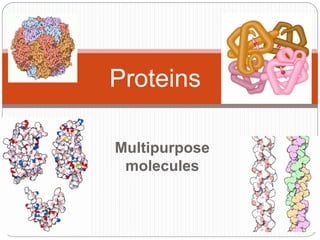
ch 3 proteins structure ppt.ppt
- 2. Proteins Most structurally & functionally diverse group of biomolecules Function: involved in almost everything Metabolism Support Transport Regulation Motion
- 3. Metabolism Enzymes Biological catalysts – speed up chemical reactions Digestive enzymes aid in hydrolysis o Lipase o Amylase o Lactase o Protease Molecular Biology o Polymerase o Ligase Industry o Dairy, baby food, rubber, beer, photography, contact lense cleaner
- 4. Support Structural proteins Keratin – hair and nails Collagen – supports ligaments, tendons, and skin Silk – cocoons and spider webs
- 5. Transport Channel and carrier proteins in the cell membrane Allows substances to enter and exit the cell Transport molecules in blood Hemoglobin – transports oxygen in the blood
- 6. Defense Antibodies Combat bacteria and viruses
- 7. Regulation Hormones Intercellular messengers that influence metabolism Insulin – regulates the amount of glucose in the blood and in cells Human growth hormone – its presence determines the height of an individual Receptor Proteins Built into the membranes of nerve cells Detect chemical signals (neurotransmitters) released by other nerve cells
- 8. Motion Muscle contraction Actin and myosin – make up muscle fibers Motor proteins within the cell Allow cell components to move from place to place Flagella- move the cell Cilia- move contents around the cell
- 9. Proteins Structure: monomer = amino acids 20 different amino acids 12 made by body 8 essential amino acids (must get from food) polymer = polypeptide protein can be one or more polypeptide chains folded & bonded together large & complex molecules complex 3-D shape Rubisco hemoglobin growth hormones
- 10. Amino acids Structure: central carbon (α carbon) amino group carboxyl group (acid) R group (side chain) variable group confers unique chemical properties of the amino acid —N— H H C—OH || O R | —C— | H
- 11. Nonpolar amino acids nonpolar & hydrophobic
- 12. Polar amino acids polar or charged & hydrophilic
- 13. Sulfur containing amino acids Form disulfide bridges cross links betweens sulfurs in amino acids You wondered why perms smelled like rotten eggs? H-S – S-H
- 14. Building proteins Peptide bonds linking NH2 of one amino acid to COOH of another C–N bond N terminus – C terminus peptide bond dehydration synthesis
- 15. Protein structure & function Function depends on structure 3-D structure twisted, folded, coiled into unique shape hemoglobin collagen pepsin
- 16. Primary (1°) structure Order of amino acids in chain amino acid sequence determined by gene (DNA) slight change in amino acid sequence can affect protein’s structure & it’s function even just one amino acid change can make all the difference! lysozyme: enzyme in tears & mucus that kills bacteria
- 18. Secondary (2°) structure “Local folding” folding along short sections of polypeptide interaction between adjacent amino acids H bonds between backbones (O:H) -helix -pleated sheet Fibrous proteins – only have secondary structure Keratin Silk
- 20. Tertiary (3°) structure “Whole molecule folding” created when the secondary structure fold and form bonds to stabilize the structure into a unique shape determined by interactions between R groups Hydrophobic interactions anchored by disulfide bridges Ionic Bonds between R groups Hydrogen bonds between backbones Van der Waals Force (velcro) Globular (spherical) proteins – have tertiary structure enzymes
- 21. Quaternary (4°) structure two or more tertiary folded peptide subunits bonded together to make a functional protein Hemoglobin – 4 polypeptides Collagen – 3 polypeptides hemoglobin collagen = skin & tendons
- 22. Protein structure (review) 1° 2° 3° 4° aa sequence peptide bonds H bonds R groups hydrophobic interactions, disulfide bridges, ionic bonds determined by DNA multiple polypeptides hydrophobic interactions
- 23. Denature a protein Unfolding a protein/changes the shape disrupt 3° structure pH temperature unravels or denatures protein disrupts H bonds, ionic bonds & disulfide bridges destroys functionality